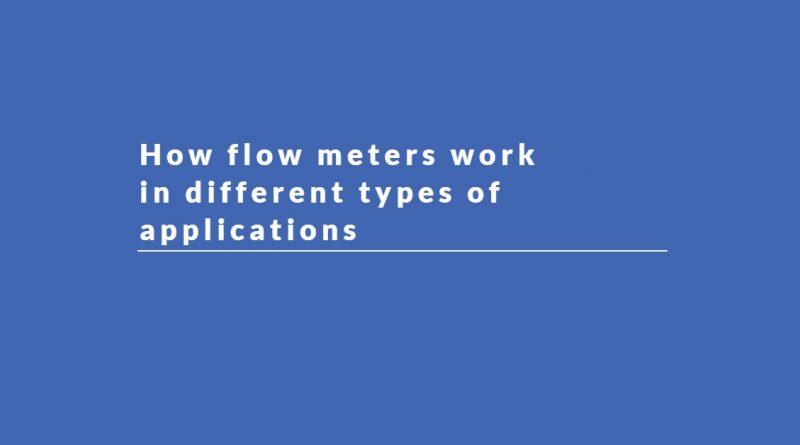How flow meters work in different types of applications
Flow meters are devices that people use to measure the linear and nonlinear mass and volume of fluids or gasses in a pipe or tube. The devices can measure the flow rate of a liquid for the user to read and record. All flow meters are suitable for improving measurement resolution and accuracy.
Various industries have different names for flow meters. The common flow meter names they use are liquid meters, flow gauge, flow indicator, and flow rate sensors. Unlike other measurement devices, flow meters can also measure the flow rate in rivers, lakes and streams.
As noted before, flow meters work in different ways to measure the flow rate of a gas or liquid passing through a flow meter sensor or tube. They usually give out accurate results, especially during research activities and control systems.
How flow meters work in different types of applications
There are different types of flow meter applications and the specific flow meter devices used in each application. Some of the applications include;
1) Used to measure the flow of corrosive liquids
The types of flow meters that we use in measuring the flow rate of corrosive liquids are ultrasonic or magnetic flow meters. They are designed so that the two transducers work by receiving and transferring the flow downstream and upstream, respectively. Below is an example of an ultrasonic flow meter.
The time required by the waves to travel from downstream transducer to upstream transducer is always higher than the time the waves take to travel from an upstream transducer to downstream transducer when the difference is greater, the velocity increases and vice versa.
2) Used to measure the flow of clean gases and liquids
Flow meters used in measuring the flow rate of clean gases and liquids are; venturi, annubar, orifices, vortex flow meters, e.t.c. The vortex works by measuring the volume or mass of gasses, steam or liquid in the flow meter sensor placed in the fluid. During this, the float that balances the tube remains steady as the liquid or gas moves upward. The image below shows a vortex flow meter.
When an annubar flow meter is used, a pressure sensor is placed inside the media line to record the pressure through the openings in the probe. One can calculate the flow measurements directly since the dynamic and differential pressure corresponds.
3) Used in Abrasive slurries flow measurement
The commonly used flow meters here are Coriolis mass or magnetic flow meters. They measure the flow rate by causing Coriolis forces to occur depending on the mass flow of the liquid or gas in the tube. A pick-up senses the rotary movement of the flow, thus recording the flow rate of the substance.
Example of a Coriolis mass flow meter.
4) Used to measure the flow rate of dirty liquids
In dirty liquids, we usually use Coriolis or magnetic flow meters. We can also use the venturi flow meters in limited applications. The Coriolis measures the flow rate of a dirty liquid and brings out the most accurate reading since the Coriolis forces push the liquid to flow on the flow sensor or pipe. Many industries use this flow meter because of the accuracy it provides and the low maintenance cost.
5) Used to measure the flow rate of dirty gases
The most suitable flow meter types in measuring the flow of dirty gasses are the vortex flow meters though we can also use thermal mass flow meters in limited applications. The vortex flow meters work when you put an obstruction in the tube or pipe where the liquid flow is right. The vortices shedding frequency pipe base is directly proportional to the velocity of the fluid as shown in the diagram below;
6) Used in measuring a saturated steam
We use the type of flow meters here like, orifice displacement flow meters or vortex flow meters. Variable area meters may be used in limited applications. When you place saturated steam in a pipe or tube, the vortex flow meters detect the changes in the vortex pressure that make the flow rate directly proportional to the vortices created.
7) Used in cryogenic applications
In cryogenic applications, orifice plates or venturi flow meters are normally used in measuring the flow rate. The venturi meters measure the differential pressure and constrict liquids that drop in the sensor to increase and reduce the velocity and pressure respectively in the upstream.
8) Used in measuring the flow rate of viscous liquids
The type of flow meter that people normally use here is the magnetic flow meter. They work under a magnetic induction law given by Faraday. The law states that when liquid conduction moves inside a magnetic area, the two electrodes generate a voltage at the right angle with the liquid velocity and the oriented field. Below is a magnetic flow meter;
Conclusion
Various types of flow meters work in different types of applications but always aim to measure the flow rate in gases, liquids, or steam. You should choose the best flow meter for your application by knowing how they operate and the cost of each type.




